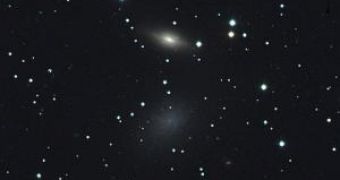For 23 years, astronomers have been convinced that the space duo formed by the galaxies NGC 5011 B and C was at the same distance from Earth.
But employing the 3.6-m ESO telescope at La Silla they discovered that NGC 5011C is not a giant but a dwarf galaxy, belonging to a group of galaxies neighboring the Milky Way.
NGC 5011C is situated towards the Centaurus constellation, in the direction of the Centaurus A group of galaxies and the Centaurus cluster of galaxies.
NGC 5011 B is roughly 13 million light-years from the Milky Way, while the NGC 5011C is 12 further. NGC 5011C's traits with its low density of stars and lack of specific features made the researchers characterize it as a nearby dwarf elliptical galaxy, but its distance, as it appears in the scientific literature, refers to it as a member of the more remote Centaurus cluster.
In this case it would be a part of the same cluster as its brighter companion, the lenticular galaxy NGC 5011B. "This is however a problem, as despite the small distance between the two galaxies this would imply from their projection on the sky if they were indeed at the same distance - only 45,000 light-years, half the size of our Milky Way - there is no obvious sign of interaction between the two", said Ivo Saviane, from ESO.
If the two galaxies were located at the same distance, then NGC 5011C would be larger than NGC 5011B in real size, something really odd. The La Silla telescope revealed that the two galaxies have very different redshifts, with NGC 5011C moving away from us five times slower than the other galaxy. "This indicates they are at different distances and not at all associated. Clearly, NGC 5011C belongs to the close group of galaxies centred around Centaurus A, while NGC 5011B is part of the much farther Centaurus cluster", said Helmut Jerjen (Mt Stromlo Observatory, Australia), involved in the research.
The astronomers could find more details: NGC 5011B is composed of heavier chemical elements than NGC 5011C, while NGC 5011C compasses just about 10 million times the Sun's mass, being therefore a true dwarf galaxy.
Our own galaxy, the Milky Way, has thousands of times more stars. "Our new observations with the 3.6-m ESO telescope thus confirm a new member of the nearby Centaurus A group whose true identity remained hidden because of coordinate confusion and wrong distance estimates in the literature for the last 23 years," says Saviane.
The team also determined that NGC 5011C is located 500,000 light-years away from the dominant galaxy in its group, Centaurus A.

 14 DAY TRIAL //
14 DAY TRIAL //